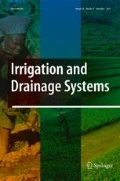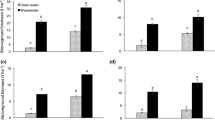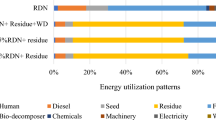Abstract
In 2006 a comprehensive sampling program was undertaken in two pre-selected peri-urban villages in Faisalabad, Pakistan to evaluate the soil and agronomic impacts of long-term (25–30 years) untreated wastewater re-use on wheat grain and straw yields and attributes of wheat straw fodder quality. Soil SAR, ESP, RSC and ECe were 63%, 37%, 31%, and 50% higher under wastewater (WW) as compared with canal water (CW) irrigated plots. Further, 2.7 and 6.65 fold increases in soil NO −3 + NO −2 - N and Olsen-P were observed in WW as compared with CW irrigated plots. However, no significant differences in grain yield, wheat straw biomass, or fodder quality attributes were observed between WW and CW irrigated plots. In addition, for both CW and WW irrigated plots wheat straw, Cd and Pb concentrations were orders of magnitude below the EC Maximum permissible levels for Pb and Cd in feed materials and thus pose no threat to the fodder-livestock food chain. Further, elevated soil N associated with WW irrigated plots has a significant (p < 0.01) positive influence on fodder quality by increasing the N content. Factorial ANOVA with covariance indicates that effective management of the elevated soil ECe in WW irrigated plots would increase grain yield and wheat straw biomass by 853 kg ha−1 (19.5%) and 819 kg ha−1 (18.6%) respectively as compared with CW irrigated plots. In Faisalabad, if managed appropriately to address emerging salinity issues the contribution of wastewater irrigation to the achievement of MDGs 1 and 7 could be significant if adverse impacts remain as marginal as found in this study.




Similar content being viewed by others
References
AATSE (2004) Water recycling in Australia: a review undertaken by the Australian Academy of Technological Sciences and Engineering (AATSE) Water recycling in Australia.
Agricultural Census Organization (ACO) (2007) Pakistan livestock census 2006. Government of Pakistan, Statistics Division, Pakistan
Agricultural Census Organization (ACO) (2008) Ministry of Economic Affairs and Statistics, Government of Pakistan, Lahore, Pakistan. http://www.statpak.gov.pk/depts/aco/statistics/.html
Alavi-Panah SK, Zehtabian GR (2002) A database approach for soil salinity mapping and generalization from remotely sensed data and geographic information system. FIG XXII International Congress 19–26 April, Washington, DC
Angelakis AN, Marecos Do Monte MHF, Bontoux LA, Asano T (1999) The status of wastewater reuse practice in the Mediterranean Basin: need for guidelines. Water Resour 33:2201–2217
APHA (1998) Standard methods for the examination of water and wastewater, 20th edn. American Public Health Association, Washington DC
Ayers RS, Westcott DW (1985) Water quality for agriculture. FAO Irrigation and Drainage Paper 29.Food and Agriculture Organization of the United Nations, Rome
Bahmanyar MA (2008) Cadmium, nickel, chromium and lead levels in soils and vegetables under long-term irrigation with industrial wastewater. Commun Soil Plant Anal 39:2068–2079
Bahri A, Brissaud F (1996) Wastewater reuse in Tunisia: assessing a national policy. Water Sci Technol 33:87–94
Blümmel M, Ørskov ER (1993) Comparison of in vitro gas production and nylon bag degradability of roughages in predicting feed intake in cattle. Anim Feed Sci Technol 40:109–119
City District Government Faisalabad (2005) Community Development Department. http://www.faisalabad.gov.pk/departments/community_development.php
Ensink JHJ (2006) Wastewater quality and the risk of hookworm infections in Pakistani and Indian sewage farmers. Thesis submitted for the degree of Doctor of Philosophy of the University of London
FAO (1988) FAO-UNESCO Soil Map of the world, Revised Legend. World Soil Resources Report 60. Food and Agriculture Organization, Rome, Italy
Gupta N, Khan DK, Santra SC (2008) An assessment of heavy metal contamination in vegetables grown in wastewater irrigated areas of Titagarh, West Bengal, India. Bull Environ Contam Toxicol 80:115–118
HACH (1997) Water analysis handbook 3rd Edition. Loveland, Colorado, USA: HACH Company
Iimura K (1981) Chemical forms and behaviour of heavy metals in soils. In: Kitagishi K, Yamane I (eds) Heavy metal pollution in soils of Japan. Japan Scientific Societies, Tokyo, pp 27–35
Janali MK, Kazi TG, Arain MB, Afridi HI, Jalbani N, Memon AR (2007) Heavy metal contents of vegetables grown in soil, irrigated with mixtures of wastewater and sewage sludge in Pakistan, using ultrasonic-assisted pseudo-digestion. J Agron Crop Sci 193:221–228
Jimenez B, Asano T (2008) International survey on water reuse. International Water Association Publishing, London
Kempers AJ, Luft AG (1988) Re-examination of the determination of environmental Nitrate as Nitrite by reduction with hydrazine. The Analyst 113:1117–120
Krom M (1980) Spectrophotometric determination of ammonia: A study of modified Berthelot reaction using Salicylate and dichloroisocyanurate. The Analyst 105:305–316
Loveday J, Beatty HJ, Norris JM (1972) Comparison of current methods for evaluating irrigation soils. CSIRO Division of Soils Technical Bulletin No. 14, Canberra
McGrath SP, Cunliffe CH (1985) A simplified method for the extraction of the metals Fe, Zn, Cu, Ni, Cd, Pb, Cr, Co and Mn from soils and sewage sludges. J Sci Food Agric 36:794–798
McLaughlin MJ, Palmer LT, Tiller KG, Beech TW, Smart MK (1994) Increasing soil salinity causes elevated cadmium concentrations in field-grown potato tubers. J Environ Qual 23:1013–1018
McLaughlin MJ, Tiller KG, Smart MK (1997) Speciation of cadmium in soil solution of saline/sodic soils and relationship with cadmium concentrations in potato tubers. Aust J Soil Res 45:1483–95
Menke KH, Steingass H (1988) Estimation of the energetic feed value from chemical analysis and in vitro gas production using rumen fluid. Anim Res Dev 28:7–55
Molle F, Berkhoff J (2006) Cities versus agriculture. Revisiting Intersectoral Water Transfers, Potential Gains and Conflicts. In: Molden D (ed) Water for food, water and life. Comprehensive assessment of water management in agriculture. Earthscan, and Colombo: International Water Management Institute, London
Murtaza G, Ghafoor A, Qadir M (2006) Irrigation and soil management stratagies for using saline-sodic water in a cotton-wheat rotation. Agric Water Manag 81:98–114
Murtaza G, Ghafoor A, Qadir M (2008) Accumulation and implications of cadmium, cobalt and manganese in soils and vegetables irrigated with city effluent. J Sci Food Agric 88:100–107
Nelson DW, Sommers LE (1996) Carbon and organic matter. In: Sparks DL (Ed) Methods of Soil Analysis Part 3, Chemical Methods, Soil Sci. Soc. Am. and Am. Soc. Agron. Madison, Wisconsin, 961–1010
Olsen SR, Sommers LE (1982) Phosphorus. In: Page AL, Miller RH, Kenny DR (eds) Methods of soil analysis—Part 2, chemical and microbial properties, 2nd edn. American Society of Agronomy, Madison, pp 403–430
Pescod MD (1992) Wastewater treatment and use in agriculture. Irrigation and Drainage Paper 47, Food and Agriculture Organization of the United Nations, Rome,, Italy
Qadir M, Minhas PS (2008) Wastewater use in agriculture: saline and sodic waters. In: Trimble SW (ed) Encyclopedia of water science. Taylor & Francis, New York, pp 1307–10
Qadir M, Oster JD (2004) Crop and irrigation management strategies for saline sodic soils and waters aimed at environmentally sustainable agriculture. Sci Total Environ 323:1–19
Qadir M, Schubert S (2002) Degradation processes and nutrient constraints in sodic soils. Land Degrad Dev 13:275–294
Qadir M, Schubert S, Ghafoor A, Murtaza G (2001) Amelioration strategies for sodic soils: a review. Land Degrad Dev 12:357–86
Qadir M, Tubeileh A, Akhtar J, Labri A, Minhas PS, Khan MA (2008) Productivity enhancement of salt-affected environments through crop diversification land degradation and development 19:429–53
Qadir M, Wichelns D, Raschid-Sally L, Minhas PS, Drechsel P, Bahri A, McKornick P, (2007) Agricultural use of marginal quality water—oppurtunities and challenges. In: Molden D (Ed) Water for Food, Water and Life. Comprehensive Assessment of Water Management in Agriculture, London: Earthscan, and Colombo: International Water Management Institute
Qishlaqi A, Moore F, Forghani G (2008) Impact of untreated wastewater irrigation on soils and crops in Shiraz suburban area, SW Iran. Environ Monit Assess 141:257–273
Rhoades JD (1996) Salinity, electrical conductivity and total dissolved solids. In: Methods of Soil Analysis Part 3. Chemical methods. American Society of Agronomy, Madison, Wisconsin, USA, 417–435
Scott CA, Faruqui NI, Raschid-Sally L (2004) (Eds.) Wastewater use in irrigated agriculture: confronting the livelihood and environmental realities. Wallingford, UK; Colombo, Sri Lanka; Ottawa, Canada: CABI Publishing; IWMI; IDRC
Searle PL (1984) The Berthelot or indophenol reaction and its use in the analysis chemistry of nitrogen. The Analyst 109:549–565
Shariatpanahi M, Anderson AC (1985) Accumulation of cadmium, mercury and lead by vegetables following long-term land application of wastewater. Sci Total Environ 52:41–47
Sharma RK, Agrawal M, Marshall F (2007) Heavy metal contamination of soil and vegetables in suburban areas of Varanasi, India. Ecotoxicol Environ Saf 66:258–266
Sharma DP, Rao KVGK (1998) Strategy for long term use of saline drainage water for irrigation in semi-arid regions. Soil Tillage Res 48:287–95
Shirokova Y, Forkutsa I, Sharafutdinova N (2000) Use of electrical conductivity instead of soluble salts for soil salinity monitoring in Central Asia. Irrig Drain Syst 14:199–205
Tanji KK, Kielen NC (2002) Agricultural drainage water management in arid and semi-arid areas. Irrigation and Drainage Paper 61. Food and Agriculture Organization of the United Nations, Rome, Italy
Thomas GW (1982) Exchangeble cations. In: Page AL, Miller RH, Kenny DR (eds) Methods of soil analysis—Part 2, chemical and microbial properties, 2nd edn. American Society of Agronomy, Madison, pp 159–165
Thomas GW (1996) Soil pH and soil acidity chapter 16. In: Methods of Soil Analysis Part 3. Chemical methods. American Society of Agronomy, Madison, Wisconsin, USA, 475–490
USSL, Staff (1954) Diagnosis and improvement of saline and alkali soils. Agriculture Handbook 60. USDA, Washington, DC
Walkley A (1947) A critical examination of a rapid method for determining organic carbon in soils: effect of variations in digestion conditions and of inorganic soil constituents. Soil Sci 63:251–263
WAPDA (1974) Water quality and soil. A note on soil studies. Monitoring and Planning Organization, WAPDA, Lahore
WAPDA (1981) ATLAS of the soil salinity survey in irrigated area of Indus Basin 41 M-acres. Survey and Research Organization Planning Division, Lahore
WHO 2006. Guidelines for the safe use of wastewater, excreta and grey water: Wastewater use in agriculture (Volume 2) 219 pp
Yadav RK, Chaturvedi RK, Minhas PS (2006) Stage dependent tolerance of paddy (Oryza sativa) and wheat (Triticum aestivum) to organic load in distillery effluent and associated changes in soil properties. Indian J Agric Sci 76:661–666
Yadav RK, Goyal B, Sharma RK, Dubey SK, Minhas PS (2002) Post-irrigation impact of domestic sewage effluent on composition of soils, crops and groundwater—a case study. Environ Int 28:481–486
Acknowledgements
The authors would like to acknowledge the funding support provided by BMZ (Bundesministerium für wirtschaftliche Zusammenarbeit und Entwicklung) under the project “Ensuring Health and Food Safety from Rapidly Expanding Wastewater Irrigation in South Asia”. In addition, the authors would like to recognize inputs of laboratory staff from AYUB Agricultural Research Institute, Faisalabad, Pakistan and the ICRISAT Central Laboratory, Hyderabad, India.
Author information
Authors and Affiliations
Corresponding author
Rights and permissions
About this article
Cite this article
Simmons, R.W., Ahmad, W., Noble, A.D. et al. Effect of long-term un-treated domestic wastewater re-use on soil quality, wheat grain and straw yields and attributes of fodder quality. Irrig Drainage Syst 24, 95–112 (2010). https://doi.org/10.1007/s10795-009-9085-7
Published:
Issue Date:
DOI: https://doi.org/10.1007/s10795-009-9085-7




